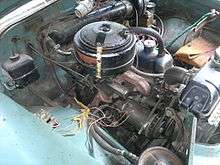Choke valve
A choke valve is a type of valve designed to create a choked flow in a fluid line in an automobile. The viscosity of the fluid passing through the valve is irrelevant in understanding how the mechanism works. The rate of flow is determined only by the ambient pressure on the upstream side of the valve.
In automotive contexts, a choke valve modifies the air pressure in the intake manifold of an internal combustion engine, thereby altering the ratio of fuel and air quantity entering the engine. Choke valves are generally used in naturally aspirated engines with carburetors to supply a richer fuel mixture when starting the engine. Most choke valves in engines are butterfly valves mounted in the manifold above the carburetor jet to produce a higher partial vacuum, which increases the fuel draw.
In heavy industrial or fluid engineering contexts, a choke valve is a particular design of valve that raises and lowers a solid cylinder (called a "plug" or "stem") which is placed around or inside another cylinder that has holes or slots. The design of a choke valve means fluids flowing through the cage are coming from all sides and that the streams of flow (through the holes or slots) collide with each other at the center of the cage cylinder, thereby dissipating the energy of the fluid through "flow impingement". The main advantage of choke valves is that they can be designed to be totally linear in their flow rate.
Automotive
A choke valve is sometimes installed in the carburetor of internal combustion engines. Its purpose is to restrict the flow of air, thereby enriching the fuel-air mixture while starting the engine. Depending on engine design and application, the valve can be activated manually by the operator of the engine (via a lever or pull handle) or automatically by a temperature-sensitive mechanism called an autochoke.
Choke valves are important for naturally-aspirated gasoline engines because small droplets of gasoline do not evaporate well within a cold engine. By restricting the flow of air into the throat of the carburetor, the choke valve reduces the pressure inside the throat, which causes a proportionally-greater amount of fuel to be pushed from the main jet into the combustion chamber during cold-running operation. Once the engine is warm (from combustion), opening the choke valve restores the carburetor to normal operation, supplying fuel and air in the correct stoichiometric ratio for clean, efficient combustion.
Note that the term "choke" is applied to the carburetor's enrichment device even when it works by a totally different method. Commonly, SU carburetors have "chokes" that work by lowering the fuel jet to a narrower part of the needle. Some others work by introducing an additional fuel route to the constant depression chamber.
Chokes were nearly universal in automobiles until fuel injection began to supplant carburetors. Choke valves are still common in other internal-combustion applications, including most small portable engines, motorcycles, small propeller-driven airplanes, riding lawn mowers, and normally-aspirated marine engines.

Industrial
Heavy-duty industrial choke valves control the flow to a certain flow coefficient (Cv), which is determined by how far the valve is opened. They are regularly used in the oil industry. For highly-erosive and corrosive purposes, they are often made of tungsten carbide or inconel.